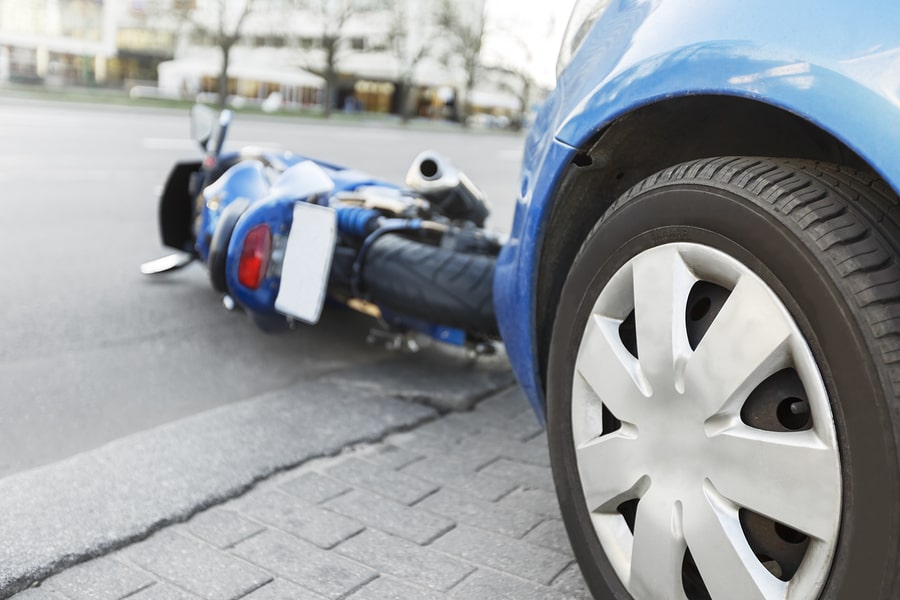
Drivers of other vehicles cause an astonishing number of motorcycle accidents. Even more astounding, more than 80 percent of motorcycle accidents result in the motorcycle rider being injured or killed. Even so, motorcycle accident fatalities are on the decline, dropping to 4,985 deaths, a 5 percent decline from the previous year. If you are suffering from injuries because of a car accident, or if you lost a loved one in a car accident, Contact an experienced Georgia motorcycle accident attorney immediately to learn about your legal options.
Nonetheless, motorcycle riders are roughly 28 times more likely than people in passenger cars to die in a traffic accident, based on miles driven. In just one year, motorcycle drivers and passengers made up 14 percent of all traffic fatalities.
Decades ago, The Hurt Report detailed the leading causes of motorcycle accidents after a multi-year study—the most comprehensive study of motorcycle accidents ever conducted. The findings remain fairly closely in line with current federal traffic statistics.
The report found that:
- Three-quarters of motorcycle accidents involved a collision with another vehicle, usually a passenger vehicle.
- The other one-fourth of motorcycle accidents involved only the motorcycle, which either collided with a fixed object near the road or fell to the pavement because of a loss of control. Only three percent of single-vehicle accidents were a result of equipment failure of any kind. Most were caused by a flat tire leading to a loss of control of the motorcycle.
- About two-thirds of single-vehicle motorcycle accidents were the result of driver error. Often, the error involved over-braking or speeding into a turn, causing the motorcycle to fall to the pavement in the turn.
So, What Are the Top Causes of Motorcycle Accidents?
- Federal statistics show that nearly half of all fatal two-vehicle motorcycle crashes—less attention is paid to the causes of non-fatal accidents, even though approximately 89,000 people were injured in motorcycles in one recent year—occurred at traffic intersections where the passenger vehicle turned left while the motorcycle involved was going straight, overtaking, or passing other vehicles.
- Speeding accounted for 32 percent of all fatal motorcycle accidents in 2017, higher than for any other class of vehicle. By comparison, 18 percent of passenger car drivers involved in fatal crashes were speeding, Fourteen percent of light-truck drivers, and only 7 percent for drivers of large trucks.
- Alcohol also played a large role in 2017 fatal motorcycle crashes, with 28 percent of motorcyclists killed in traffic accidents had a blood alcohol level of 0.08—the legal limit in most states—or higher, while another 7 percent had lower alcohol levels.
- Industry publications also peg intersections as danger zones for motorcycle crashes, often due to other vehicles violating the motorcyclist’s right of way or committing other traffic infractions.
- Driver inattention—either by the motorcyclist or by other drivers—also is cited as a major traffic hazard for motorcyclists.
Other trade publications put together more comprehensive lists of accident causes and how to avoid them. One industry site created its own top 10 for motorcycle accident causes that has a lot of support from federal statistics, as well as from motorcycle riding experience, with the list including:
- Cars or other vehicles turning leftin front of motorcyclists is listed as the publication’s top cause of motorcycle accidents, a position supported by government statistics. Such accidents occur because of inattention on the part of the car’s driver, failure by the car’s driver to check mirrors before turning, the motorcyclist being in the car’s blind spot, the driver of the car failing to look over his shoulder, or simply a failure by the car’s driver to notice the motorcyclist.
- Hitting a patch of gravel, sand, leaves, or other loose material while negotiating a curve, laying the bike down when it slips in the loose material. This is a frequent cause of single-vehicle motorcycle accidents. Any time a rider lays his bike down, there is a risk of the rider sliding into a static object, such as a tree, utility pole, a parked car, a wall, or some other unforgiving object, the possibility of serious injuries is always there.
- Entering a turn too fast to safely negotiate the turn. As with skidding on loose material on a curve in the road, entering a turn too fast poses a serious risk to the rider when the bike goes down or leaves the road after failing to negotiate the turn.
- A car changing lanes into the motorcyclist, whether because of inattention, failure to look or check mirrors, or because the motorcyclist was in the car’s blind spot and the car driver failed to check the blind spot with an over-the-shoulder glance.
- A car striking the motorcyclist from behind, often following an unexpected stop by the motorcycle or because the presence of the motorcyclist at the stop sign simply doesn’t register with the driver of the car. While only 7 percent of motorcycle accidents involve the motorcyclist being struck from the rear by a passenger vehicle, because of the disparity in size, weight, and occupant protection, what amounts to a fender-bender for the car can result in the motorcyclist suffering severe injuries or even death, even at low speeds. If the motorcyclist stops at a traffic signal that has turned yellow and the driver of the car behind the biker had hoped to make it through before the signal turned red, the speed involved likely will be much higher and the consequences—for the motorcyclist, at least—much more serious.
- The motorcyclist locks the front brake. This is a common cause of single-vehicle motorcycle accidents. Locking the front brake—which doesn’t happen with optional anti-lock brake systems—often results in the motorcycle flipping over the now-stopped front wheel as the bike begins to skid. The rider is dumped on the ground, and the bike can cartwheel away. Injuries can result, and at high speeds, those injuries can be severe, even fatal.
- Running into an opening car door. This happens most often when traffic is stopped on the left, and cars are parked on the right. Motorcyclists sometimes do what is called lane-splitting and will take the open path between the stopped traffic on the left and the parked cars. If someone opens a car door in the line of parked cars on the right, a sudden and unavoidable obstacle is placed in the motorcyclist’s way. The collision of the motorcycle and car door can result in sudden deceleration of the motorcycle, and the rider can be ejected over the car door and sent flying.
- Similarly, motorcyclists sometimes try lane-splitting on multi-lane roads between two rows of stopped traffic. Usually, but not always, this occurs in states where lane-splitting is legal. Even though the driver of a car would be unlikely to open a car door when traffic is stopped, stranger things have happened. Also, the lanes of cars are fairly close together, leaving the motorcyclist almost no room to maneuver should something unexpected occur, such as a driver of a car in one lane deciding that the other lane will move sooner and nosing into the space between the lanes in hopes of moving over once traffic starts to move. Not the same as hitting an opening car door, but just as dangerous for the motorcyclist.
- Slippery roads and adverse weather. While only about three percent of motorcycle accidents occur in the rain (snow is not mentioned in federal statistics—the other 97 percent of accidents are reported as happening in clear or cloudy weather), those accidents can be serious. Many involve the ability to stop quickly enough or the inability to steer around hazards while still maintaining control. Many weather-related accidents end up being single-vehicle accidents that involve only the motorcycle and could be attributed to driver error.
The single most common accident cause on the list is operator impairment. For fatal motorcycle accidents, 35 percent involved some level of alcohol in the motorcyclist’s system at the time of the accident, with 28 percent at or above the legal limit. Nearly 45 percent of those accidents were single-vehicle, involving only the motorcycle.
The publication putting out the list cites the Hurt Report figure of 50 percent of all motorcycle accidents involving alcohol, so the good news is that alcohol is a factor in a smaller percentage of motorcycle accidents than it was in 1981. The bad news, obviously, is that alcohol is involved in more than a third of fatal motorcycle accidents.
Steps You Can Take to Avoid Motorcycle Accidents
Industry publications will tell you about a few simple steps to avoid motorcycle accidents. At the top of that list is, don’t assume drivers of cars actually see the motorcycle. They are looking for other cars; once they see no other cars where they want to go—be it a turn, a lane change, or any other action, such as opening a door when parked alongside a busy road—the driver of that car might not even notice motorcyclist in their path. Any car can be a threat, so act accordingly.
Be attentive and be prepared to take evasive action. Pay attention to turn signals, and even to turning wheels on cars near you. Also, pay attention to the blind spots of cars near you, and try not to stay in those blind spots. Be aware of other cars around you—including behind you—so that if you do have to take evasive action, you don’t do so right into the path of another vehicle.
For situations where other vehicles are not the threat, the solution for avoiding most accidents is simple: Don’t be the problem. So many single-vehicle motorcycle accidents are the result of driver error. Take a riding course before you actually ride a motorcycle. Keep your speed at a pace that gives you time to react to a situation, such as loose material in a curve or an unexpectedly sharp curve.
Learn and practice proper braking techniques, especially when using front brakes, so that you don’t send yourself cartwheeling down the road. Even where lane-splitting is legal, don’t do it. The time potentially gained is not worth the potential consequences, especially when riding between a lane of stopped traffic and a lane of parked cars. Maintain proper tires in good condition for when the weather is bad. Keep in mind that the first hour or so of rain—especially if it hasn’t rained in a while—floats oil, exhaust residue, and other slippery stuff to the surface of the pavement.
Avoid riding until more rain and traffic dissipate the slippery stuff. Look for rainbow slicks on the pavement—that’s oil, gas, or something else that is slippery. And keep in mind that manhole covers become skid traps in the rain.
Under all circumstances, good weather or bad, don’t drink and ride. Riding a motorcycle safely requires total control and attention. Alcohol makes both of those physiologically impossible. These simple steps can save you from injuries or even death.
Perhaps not surprisingly, the federal government recommends many of the same cautionary steps, with a couple extra thrown in. First off, the National Highway Transportation Safety Administration also recommends taking a motorcycle-training course. In some states, such a training course is required to avoid helmet requirements, but that is not why the NHTSA recommends taking the course.
All states require a motorcycle license in addition to a regular driver’s license and require written and riding skills tests to obtain one. Some states require a state-approved course to obtain a motorcycle license, while others waive the license requirement if you pass a state-sponsored skills course. To avoid that process, many riders don’t bother getting a motorcycle license.
Unfortunately, that might not be the greatest idea. Nearly 30 percent of motorcyclists in a fatal crash did not have a valid motorcycle license. Take the course, get the motorcycle license, and you will be more likely to live to enjoy riding injury- and accident-free.
In the unfortunate event that you are in an accident, contact a motorcycle accident attorney near you as soon as you can.














